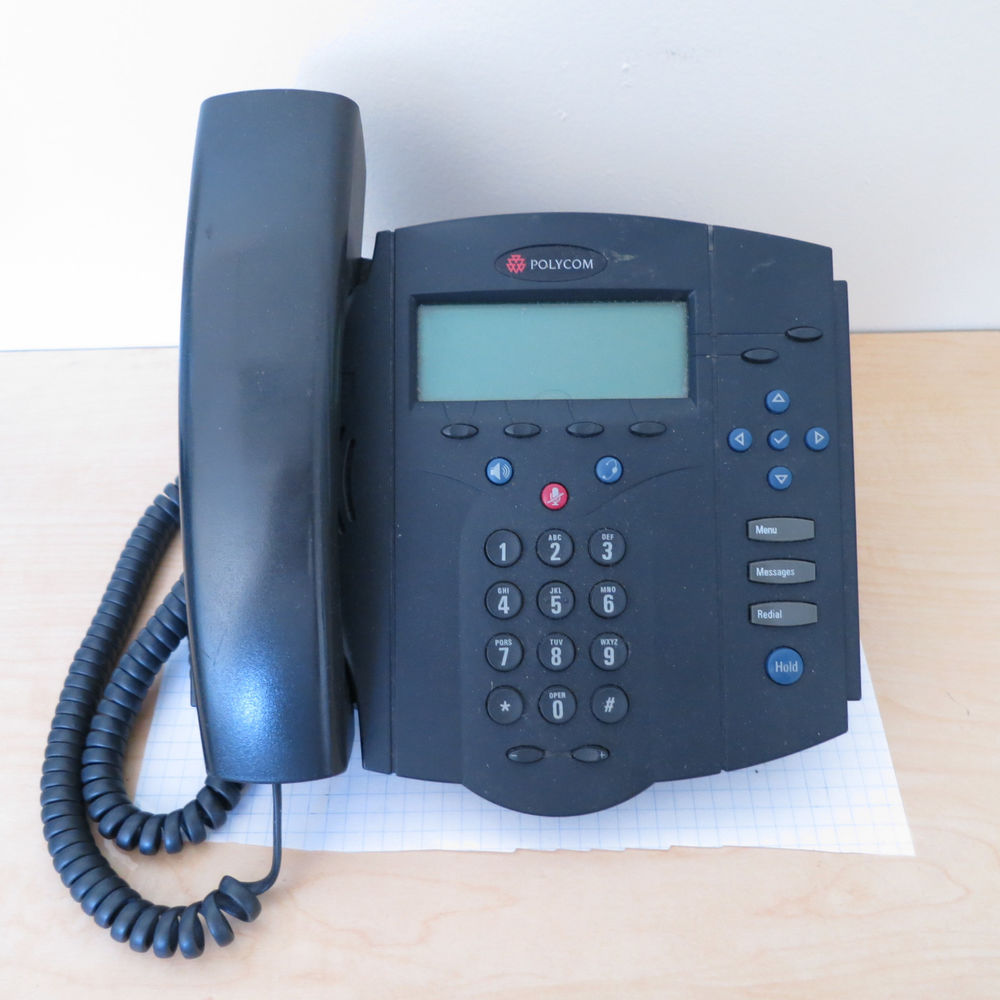
An older model SIP phone from Polycom, one of the top brands in VOIP and teleconferencing.
This is generally supported by hosted pbx systems.
Normally, I’d just write a brief description, but thought this was an opportunity to give readers more info.
What is VOIP?
VOIP stands for Voice Over IP, and that means placing telephone calls over the IP network. IP is the Internet Protocol, which we all use. VOIP is an application that runs on top of IP. This is also called IP Telephony.
How VOIP Works
It’s similar to streaming music. Your audio is turned into digital numbers, ipand then streamed to the other phone, where the numbers are converted back into sounds. The stream is sent via “packets” or chunks of data, which is how IP works.
VOIP hardphones, like this Polycom, don’t have a landline jack – they have an Ethernet port. Most phone, including the IP 430, should be powered using Power Over Ethernet PoE; that requires a special switch that supports the 802.3af or 802.3at standards. (It’s totally worth having one.)
What is the SIP protocol?
SIP means Session Initiation Protocol, and is one of several different (and incompatible) VOIP technologies. This Polycom is a SIP phone. SIP is the most generic VOIP protocol, and is implemented by hundreds of vendors and programs. SIP helps to “set up” a phone call, and it requires that the phone be communicating with a SIP server. The SIP servers all talk to each other, and cause the phone at the other end to ring.
Once a call is set up, though, the data goes directly between the two phones. That’s why it’s the session initiation protocol.
Hosted PBX Systems and Managed PBX Systems
The phone needs to talk to a SIP server. This is also called a VOIP PBX, and PBX stands for Private Branch Exchange. A PBX is an office phone system; a “exchange” is an archaic reference to how the old landline phone system was designed back in the early 20th century.
Phone numbers have three parts: the 3 digit area code, followed by a 3 digit prefix, and then a 4 digit line number. The prefix corresponded to an “exchange“, or a building with all the phone lines for a community, connected to a giant switch. You might see these buildings, today, sporting an AT&T logo. They’re large, usually don’t have windows, and you don’t even see that many people in the area.
A PBX is a private branch of the phone system, and an exchange, or line switching system. When you go to an office, or call into an office, you typically get a receptionist or a voice mail system. That’s the PBX.
A business PBX system can be built using IP business phones, like the Polycom IP 430, and a “softswitch”. A softswitch is a computer program that sets up calls between hardphones (VOIP phones that look like traditional desk phones). They can also work with softphones, or programs that let you make phone calls. A typical softswitch does more than that, and can do voicemail, or even convert SIP calls into regular telephone calls over landlines (POTS – the plain old telephone system), or configure the phone with DHCP or the BOOTP protocols.
So, the question of this section: hosted PBX or managed PBX?
Managed PBX is a computer that’s in your office, that’s controlled by some technician, remotely. I think it’s the way to go for small offices.
The main advantage, as I see it, is that the PBX can send out calls via the POTS, or a leased T1 line, or a fractional T1 line. All these technologies are called “circuit switched”, so the connection to the other end is in real-time and won’t face congestion.
Hosted PBX is a computer that’s out on the Internet, that’s controlled by some technicial. Hosted is more economical for very small offices. The price for phone service can be as low as $15 a month. My main concern is that there could be network congestion that can cause problems.
If you use hosted PBX, you need to make sure you have sufficient bandwidth, and low latency. This typically means “business class internet”.
There is an excellent use case for hosted PBX, for virtual offices. If the people are scattered across town, or the globe, putting all the people onto a single hosted PBX can give the entire company a single phone number, with each person getting an extension.
What is a VOIP Network?
Early in the SIP/VOIP days, networks ran at 10Mbps or 100Mbps, so they would get congested. To avoid problems, businesses installed a second network, with its own wiring, for VOIP.
Today, with 1000Mbps being the norm, and many offices sporting smart switches that support different quality of service (QoS) protocols, a separate VOIP network is generally unnecessary.
What Features Does the SoundPoint IP 430 Have?
It’s a SIP phone, supporting two lines (which means two configurations to connect to the PBX), that uses power over ethernet 802.3af, but can also use an AC adapter. The adapter costs more than a PoE switch, though.
It’s configured using the LCD screen, or by using the BOOTP protocol with a BOOTP server.
The station has four soft buttons, and cursor keys, and the traditional “hold” and other office phone buttons. The SoundPoint also has a speakerphone.
For Sale: Polycom IP 430
I have three of these. It’s a cheap VOIP phone.
Source: Polycom Sound Point 430 IP SIP VOIP Phone Base Handset Tested PoE
Manual
There’s a PDF manual at the Polycom website, here.
